Fractal Design Define XL R2 Case Review: Maybe We Can Have It All?
by Dustin Sklavos on February 20, 2013 12:01 PM EST- Posted in
- Cases/Cooling/PSUs
- quiet
- Fractal Design
- ATX
Noise and Thermal Testing
I went into testing the Fractal Design Define XL R2 feeling a little skeptical. The Define R4 wasn't a bad case by any stretch of the imagination, but it was an underwhelming one, and it was pretty swiftly eclipsed by Nanoxia's Deep Silence case designs. That in mind, I didn't think the XL R2 would be a poor case, but it needed to be more than an also-ran and it needed to clear the same hurdle every other quiet case must: it had to provide good thermal performance.
Per usual testing procedures, the XL R2 was tested with the middle drive cage removed, and tested at each fan setting available. Ambient temperature during testing was ~22C.
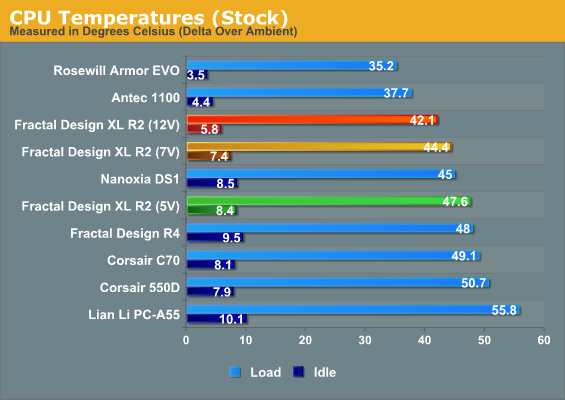
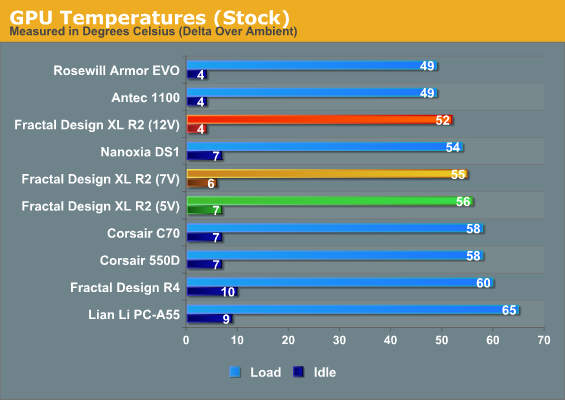
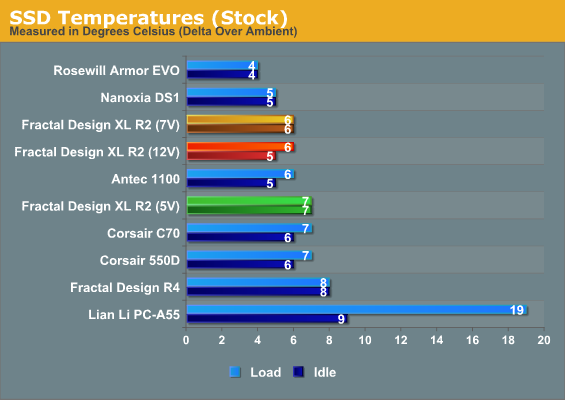
Stock thermals weren't stellar, but they were remarkably competitive. The XL R2 defeats the R4 and is capable of meeting or beating Nanoxia's Deep Silence 1.
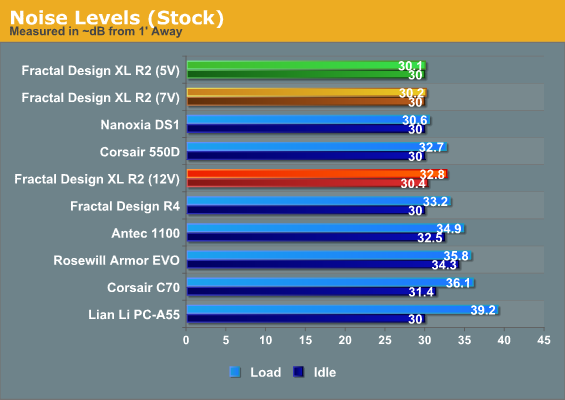
Noise levels are also nearly perfect. The XL R2 is a quiet case and, at least in our stock configuration, is able to pull good thermal performance out of low acoustics.
So far, so good. The XL R2 isn't mind-blowing but it's definitely competitive. As it turns out, though, there's a lot more fight left in the XL R2 than would first appear.
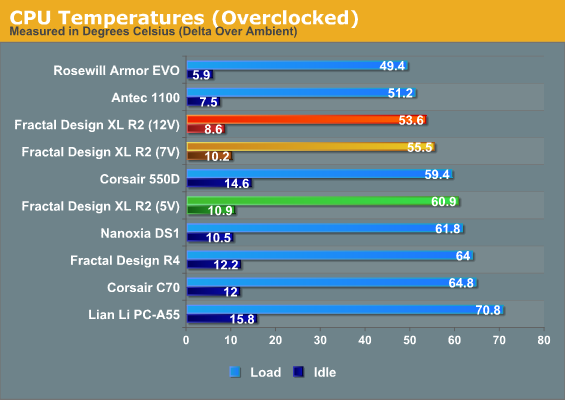
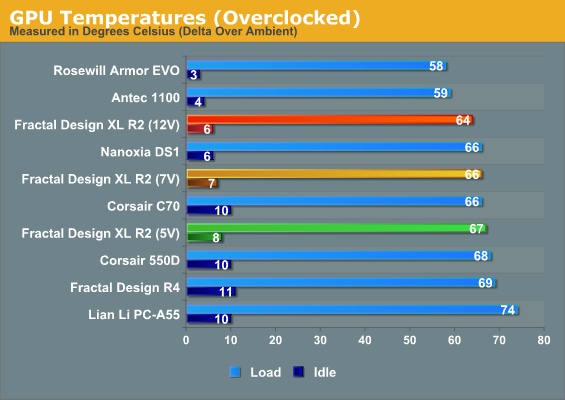
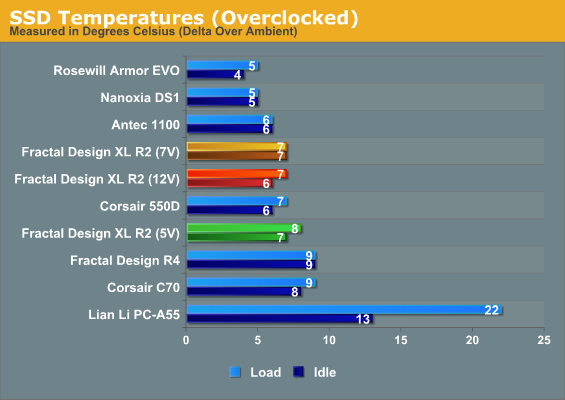
The overclocked testbed usually buries quiet cases, but the XL R2 holds its own. At worst, it's competitive with Nanoxia's formerly class-leading Deep Silence 1. At best, it eclipses it soundly.
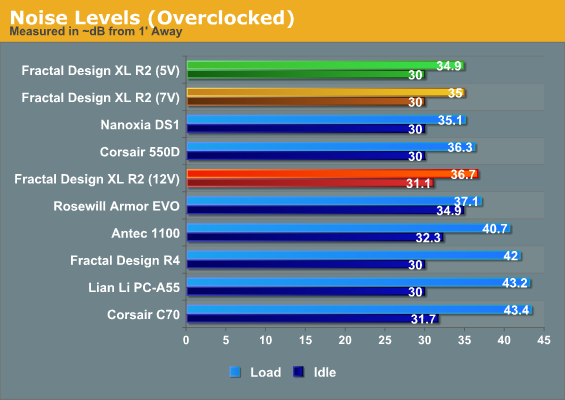
Speaking of sound, the XL R2 is also capable of running at roughly the same sound levels as Nanoxia's case while performing at least as well, if not better. It's true that Fractal Design's case does benefit from a larger footprint, but this is still a pleasant surprise to see.










46 Comments
View All Comments
arthur449 - Wednesday, February 20, 2013 - link
A useful review is one that compares an item against another using metrics that are important to the readers. Without a standard set of system components used in every review for every case in the comparison, a review turns into just another "I bought it, it works, I like it" write-up that other hardware sites like to pass off as "reviews."A solution to this could be Anandtech developing and using heating elements configured to produce similar amounts of heat and noise in similar locations to a standard ATX / mATX system. Then these elements could be adjusted to produce standard levels of heat output (65/77/95W) enthusiast heat output (130W/150W) and overclocked (200W+).
Multiples of these heating elements could be placed in the larger cases to simulate high heat GPUs and determine exactly how much thermal capacity a given case has for such a scenario.
But... custom fabrication, testing, and implementation of equipment such as this would be very spendy initially and the payoff questionable and unnecessary if the products in question fall into the disposable income category for your readership.
tim851 - Wednesday, February 20, 2013 - link
The metrics have to be relevant, though.It's reasonable to assume people are not buying big towers because they need to fill their empty rooms, but because they have components that require a big case.
And you can't tell me that one of the - if not THE - premier tech sites on the web is not able to get three different sizes of mainboards to their case reviewer and a bunch of toasty GPUs to Trip-SLI. They can go on eBay and buy an ageing Nehalem CPU and a set of GTX 285s for all I care.
Testing this monster of a case with 3 HDDs, an mATX board and a little 560 makes no sense, because the only valid conclusion can be that it is too big.
Dustin Sklavos - Thursday, February 21, 2013 - link
The problem at this point is that if I switch up to a full ATX board now, it destroys the comparative data I've accumulated over the past year. I've been working on a third, "full fat" level using this board, but ironically the board's second PCIe x16 slot isn't working and so I can't bump up testing parameters until I've sorted that out.Skolde - Wednesday, February 20, 2013 - link
Your case reviews are outstanding minus one thing:You should really consider using an ATX sized motherboard when reviewing full sized cases. I've noticed on previous reviews the habit of using small motherboards in larger cases, and it really doesn't give me a good feel for its target component size.
ATX, Micro-ATX and mini-ITX boards should be used according to the size of the case being reviewed.
Hrel - Wednesday, February 20, 2013 - link
Agreed. I've said this on other case reviews. Changing the size of the mobo but keeping the same chipset shouldn't affect any of the tests. There's really no reason not to. Unless you're buying a mimi-ATX case or smaller you are probably using a Full ATX motherboard, or larger. I stay with ATX for the expansion slots. Currently still running an old Nvidia 650 SLI chipset, but it has a USB 3.0 controller and SATA 6GBPS ports because of the expansion slots available in the motherboard. That computer is nearing it's end of life but with the SSD in it the CPU is actually the slowest part. Still run everything I do great and I have no intention of upgrading until it can't.HisDivineOrder - Wednesday, February 20, 2013 - link
Lots of people have been saying this over and over in every review like this at this site. I agree, it makes little sense to test the case with a small motherboard that most of us would never in a million years put in this case.But the reviewers are obstinate. They want you to be able to compare the reference system from a microATX case to a ATX XL case and see what the benchmarks say is the best case.
For better or worse.
tim851 - Wednesday, February 20, 2013 - link
I hate that methodology.People aren't choosing between mATX and XL-ATX.
Car reviewers figured that out a long time ago. No sense pitting a Corvette against an Escalade and a Ford Fusion. Nobody will decide between these based on trunk size or fuel economy.
There are fringe cases out there for sure, but the vast majority buys cases based on what they can do with them. In the case of a full towers that's stuffing it full of chips.
If you have an mATX board, you get an mATX case. Chances are you bought it for the size or the prize.
Either way, you ain't considering the Fractal Define XL R2...
Dustin Sklavos - Thursday, February 21, 2013 - link
The reason I made this call and stand by it:What do you lose by going with an mATX board over a standard ATX board?
haplo602 - Thursday, February 21, 2013 - link
It's not ATX vs mATX. This is an XL-ATX/E-ATX capable case, so some people will lose PCI-E slots and some even a CPU socket (my case) which is show stopper.There are plenty of cases that can fit an mATX board. It's the other end of the spectrum that's starved.
tim851 - Thursday, February 21, 2013 - link
Ask yourself this: why is anybody choosing a full tower? An mATX board, single GPU and three hard disks fit into a Silverstone TJ08. Do you think there are people undecided between a TJ08 and a Define XL waiting for a comparative review?